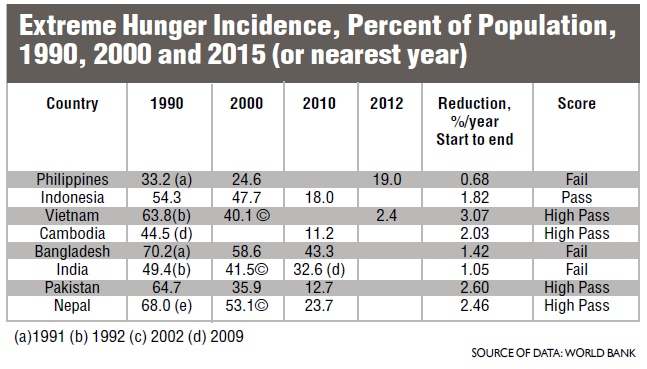MDG 2015: Benchmarking Philippine poverty scorecard
The United Nations (UN) just released the Millennium Development Goals (MDG) Report 2015.
Ban Ki-Moon, UN Secretary General in the foreword, said:
“The global mobilization behind the Millennium Development Goals has produced the most successful anti-poverty movement in history. The landmark commitment entered into by world leaders in the year 2000—to “spare no effort to free our fellow men, women and children from the abject and dehumanizing conditions of extreme poverty”—was translated into an inspiring framework of eight goals and, then, into wide-ranging practical steps that have enabled people across the world to improve their lives and their future prospects. The MDGs helped to lift more than one billion people out of extreme poverty, to make inroads against hunger, to enable more girls to attend school than ever before and to protect our planet.”
MDG Goal 1: Eradicate extreme poverty and hunger. The target was to halve extreme poverty, measured by the threshold income of $1.25 per person per day.
The MDG report claims that:
- Extreme poverty has declined significantly over the last two decades. In 1990, nearly half of the population in the developing world lived on less than $1.25 a day; that proportion dropped to 14 percent in 2015.
- Globally, the number of people living in extreme poverty has declined by more than half, falling from 1.9 billion in 1990 to 836 million in 2015.
- The proportion of undernourished people in the developing regions has fallen by almost half since 1990, from 23.3 percent in 1990-1992 to 12.9 percent in 2014-2016.
In Southeast Asia, the extreme poverty rate fell from 46 percent in 1990, 12 percent in 2000, and 7 percent in 2015. For the developing world, the corresponding numbers were 47 percent, 18 percent and 14 percent, respectively.
Article continues after this advertisementHow did the Philippines do in Southeast Asia in particular and Asia in general?
Article continues after this advertisementThe country has failed miserably in halving extreme poverty. Its rate of poverty reduction is the lowest among eight countries.
The performers were: Vietnam, Pakistan, Nepal, Cambodia and Indonesia, in that order.
India and Bangladesh also failed but with better performance than the Philippines. Note: China, Malaysia, Sri Lanka and Thailand were excluded as they have achieved low extreme poverty rates.
What went wrong for the Philippines?
It is time to again revisit rural poverty, which is near 40 percent today, the highest among peers in the Association of Southeast Asian Nations.
High rural poverty is mainly driven by low farm productivity and lack of non-farm/off-farm jobs.
Earlier research shows that the Philippines scored very low in farm productivity and agriculture exports in the Asean.
The next president must have in-depth strategic assessment of the causes of poverty.
Many scholars like Fermin Adriano, Ramon Clarete, Cristina David, Cielito Habito, Leonardo Gonzales and Roehl Briones have identified the forces behind the linkage between high rural poverty and low farm productivity.
(This article reflects the personal opinion of the author and does not reflect the official stand of the Management Association of the Philippines. The author is the Vice Chair of the M.A.P. Agribusiness and Countryside Development Committee, and the Executive Director of the Center for Food and AgriBusiness of the University of Asia & the Pacific. Feedback at <[email protected]> and < [email protected]>. For previous articles, please visit <map.org.ph>)
